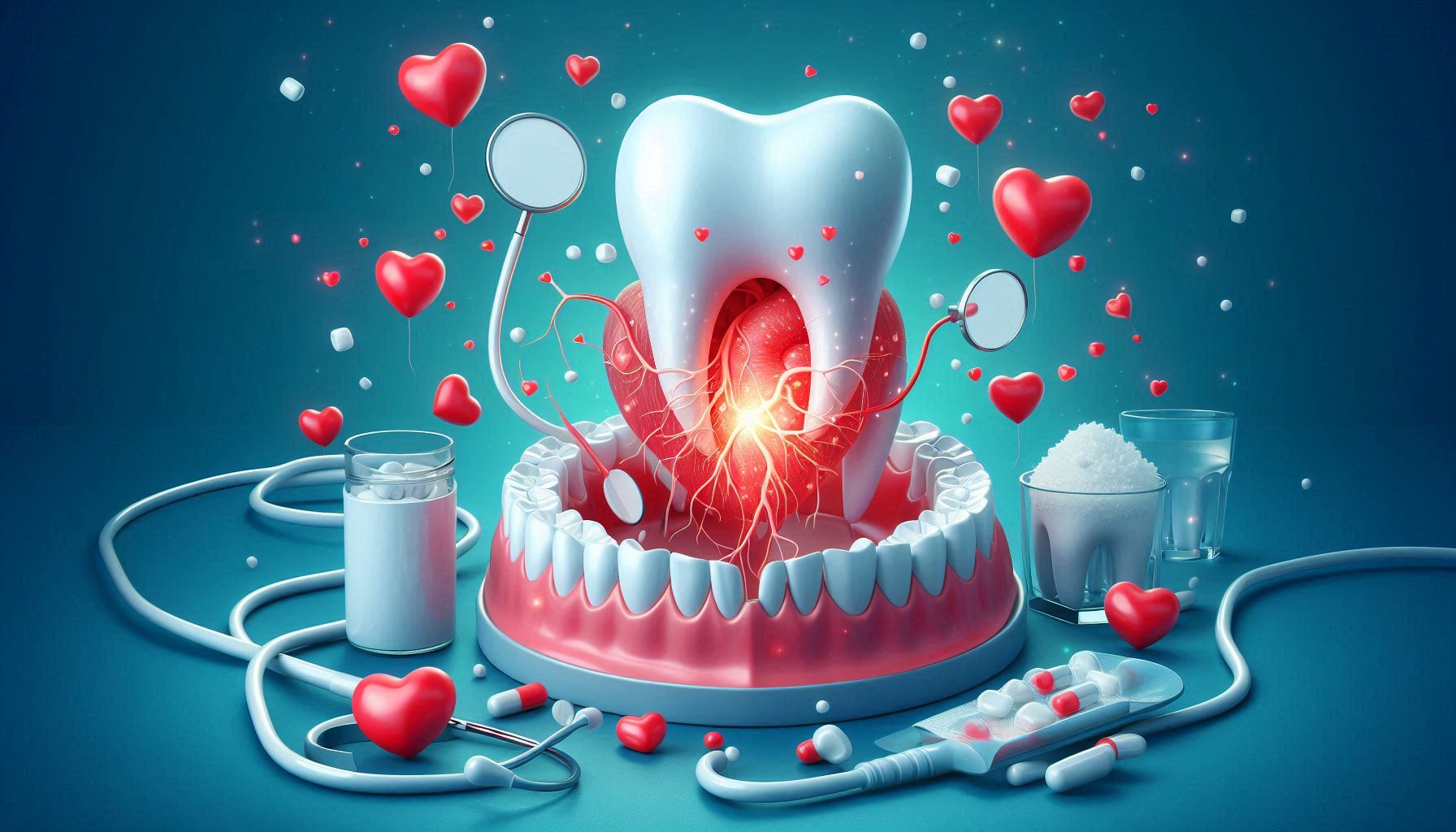In recent years, the medical community has unveiled a startling and complex connection between oral health and cardiovascular health. Many people know the basics of how to maintain their teeth and gums—brush regularly, floss daily, and avoid sugary foods. However, fewer are aware of the profound effects that oral hygiene can have on their overall health, especially when it comes to heart disease. Emerging research has begun to illuminate the relationship between gum disease (periodontal disease) and heart disease, revealing a direct, albeit indirect, link between these two seemingly unrelated health issues.
Heart disease remains the leading cause of death worldwide, with millions of people at risk. What’s alarming is that factors contributing to heart disease are often silent and unnoticed, and this includes the potential role of gum disease. Gum disease is commonly dismissed as a mild issue—something that causes bad breath, swollen gums, or bleeding while brushing. However, it has been shown that untreated gum disease can contribute to the development of serious health conditions, including heart disease, stroke, diabetes, and respiratory infections.
In this guide, we will explore in detail how gum disease can be fueling heart disease, the mechanisms behind this connection, and what individuals can do to prevent both conditions. This article will cover the following topics:
- The Nature of Gum Disease: A thorough examination of gum disease, its stages, symptoms, and the risk factors involved.
- The Heart Disease Link: How inflammation and bacteria from gum disease are implicated in heart disease development.
- The Impact of Poor Oral Hygiene: Not just limited to the heart but influencing various other systems in the body.
- Prevention and Treatment: How to reduce the risk of both gum disease and heart disease through effective oral hygiene, lifestyle changes, and medical treatments.
- The Latest Research: What clinical studies reveal about the connection between gum disease and heart disease.
Understanding Gum Disease and Its Stages
What Is Gum Disease?
Gum disease, or periodontal disease, is a term that refers to infections that affect the tissues surrounding the teeth. These tissues, which include the gums, ligaments, and bone, are critical for supporting the teeth. Periodontal disease is typically caused by poor oral hygiene practices, which allow plaque (a sticky, colorless film of bacteria) to build up on the teeth and harden into tartar (calculus). As the disease progresses, it causes inflammation, infection, and ultimately destruction of the supporting structures of the teeth.
While gum disease is a common condition, it is often preventable with good oral hygiene. The severity of gum disease can range from mild to severe, with the most serious cases potentially leading to tooth loss. The stages of gum disease include:
- Gingivitis: The earliest stage of gum disease, gingivitis, occurs when plaque and tartar cause inflammation in the gums. Gingivitis is characterized by redness, swelling, and bleeding gums, particularly during brushing or flossing. At this stage, the damage is reversible with proper oral care, and the gums can return to a healthy state.
- Periodontitis: If gingivitis is not treated, it can progress into periodontitis. Periodontitis is a more severe form of gum disease that affects the deeper tissues, including the ligaments and bone. In this stage, pockets form between the teeth and gums, allowing bacteria to infect the bone structures. This leads to more serious symptoms, such as gum recession, mobility of teeth, and eventual tooth loss.
- Advanced Periodontitis: In the most severe cases, periodontitis becomes advanced periodontitis, where the damage to the bone and tissue may be irreversible. Teeth may become loose or shift in the mouth, leading to significant functional and aesthetic issues. At this stage, intervention by a dental professional is necessary to halt the progression and attempt to preserve the remaining teeth.
Risk Factors for Gum Disease
Various factors increase the likelihood of developing gum disease. While poor oral hygiene is the primary cause, several other risk factors may contribute:
- Smoking: Smokers are more likely to develop gum disease and experience more severe cases. Smoking weakens the immune system, making it harder for the body to fight off infection, including gum infections.
- Genetics: Some people may be genetically predisposed to gum disease. Research suggests that certain genetic factors can influence an individual’s susceptibility to developing periodontal disease.
- Diabetes: People with diabetes are at an increased risk for gum disease due to their impaired immune systems and the impact of high blood sugar levels, which can reduce the body’s ability to fight infections.
- Pregnancy: Hormonal changes during pregnancy increase the risk of developing gum disease. Pregnancy gingivitis is a common issue, characterized by swollen, bleeding gums. If left untreated, it can progress to periodontitis.
- Age: Older adults are more likely to experience gum disease due to the cumulative effects of years of plaque buildup and potential lifestyle factors.
- Medications: Certain medications, such as those that reduce saliva production, can contribute to dry mouth, which increases the risk of gum disease.
The Heart Disease Connection
What Is Heart Disease?
Heart disease, also referred to as cardiovascular disease, encompasses a variety of conditions that affect the heart and blood vessels. The most common form of heart disease is coronary artery disease (CAD), which occurs when the blood vessels that supply the heart muscle become narrowed or blocked due to the buildup of plaque (atherosclerosis). This leads to reduced blood flow to the heart, which can result in chest pain (angina), heart attacks, and, over time, heart failure.
Other forms of heart disease include arrhythmias (abnormal heart rhythms), heart valve disease, and congestive heart failure. Although many factors contribute to the development of heart disease, including high blood pressure, high cholesterol, and smoking, recent research has highlighted a potential link between gum disease and cardiovascular risk.
The Role of Inflammation in Heart Disease
At the core of both gum disease and heart disease is inflammation. Chronic inflammation has long been recognized as a key driver in the development of cardiovascular disease. Inflammation in the blood vessels can contribute to the formation of plaque, a condition known as atherosclerosis. This plaque buildup narrows the arteries, reducing blood flow and increasing the risk of blood clots, which can lead to heart attacks and strokes.
Inflammation can be triggered by a variety of factors, including infections, injuries, and chronic diseases. In the case of gum disease, the inflammation begins in the gums but can spread to other parts of the body, contributing to systemic inflammation.
Bacteria: The Culprit in Gum Disease and Heart Disease
Research has shown that certain bacteria found in the mouth, such as Porphyromonas gingivalis and Treponema denticola, play a significant role in the progression of gum disease. These bacteria can enter the bloodstream through bleeding gums and travel to other parts of the body, including the heart.
Once in the bloodstream, the bacteria can cause further inflammation and contribute to the development of atherosclerosis. Studies have shown that people with gum disease often have higher levels of C-reactive protein (CRP), a marker of inflammation that is also elevated in people with heart disease.
Furthermore, these bacteria can trigger an immune response in the body, which leads to the production of pro-inflammatory cytokines. These cytokines contribute to the thickening of the artery walls and the formation of plaque, increasing the risk of cardiovascular events like heart attacks and strokes.
The Evidence: Clinical Studies and Research
Numerous studies have investigated the connection between gum disease and heart disease. In 2010, a study published in the Journal of Periodontology found that individuals with severe gum disease were nearly twice as likely to suffer from heart disease compared to those with healthy gums. Another study in the American Heart Journal concluded that treating gum disease could reduce the levels of systemic inflammation and potentially lower the risk of cardiovascular events.
The American Heart Association (AHA) has acknowledged the potential link between gum disease and heart disease, urging individuals to prioritize both oral and cardiovascular health.
The Impact of Poor Oral Hygiene on Overall Health
Beyond the Heart
The effects of gum disease extend far beyond the heart. Research has shown that poor oral hygiene and untreated gum disease can contribute to a variety of systemic health problems, including:
- Stroke: Like heart disease, stroke is linked to the buildup of plaque in the arteries. People with gum disease have an increased risk of having a stroke, especially if the infection is left untreated.
- Diabetes: Gum disease and diabetes have a bidirectional relationship. Not only can gum disease make it harder for people with diabetes to control their blood sugar levels, but elevated blood sugar can also worsen gum disease.
- Respiratory Infections: Bacteria from the mouth can be inhaled into the lungs, leading to respiratory infections such as pneumonia. People with periodontal disease are at greater risk for developing these infections.
- Alzheimer’s Disease: Emerging research suggests that gum disease may be linked to cognitive decline and Alzheimer’s disease. Certain bacteria from the mouth have been found in the brains of people with Alzheimer’s, raising the possibility that chronic oral infections may contribute to the development of dementia.
Systemic Inflammation: A Dangerous Consequence
Chronic inflammation caused by gum disease can exacerbate a wide range of health problems. This inflammation affects the body’s ability to heal and fight infections, and it has been linked to the progression of several chronic conditions, such as:
- Arthritis: Inflammation caused by gum disease may worsen the symptoms of rheumatoid arthritis and other inflammatory conditions.
- Kidney Disease: Studies have found that people with periodontal disease have a higher risk of kidney disease, possibly due to the systemic effects of inflammation.
Prevention and Treatment of Gum Disease to Protect Heart Health
Oral Hygiene Practices
Maintaining good oral hygiene is the most effective way to prevent gum disease and reduce the risk of heart disease. Key practices include:
- Brushing: Brush your teeth at least twice a day with fluoride toothpaste to remove plaque and food particles. Make sure to brush for at least two minutes, paying attention to the gumline and hard-to-reach areas.
- Flossing: Floss daily to remove plaque and food particles from between the teeth and under the gumline. Flossing helps prevent gum disease and tooth decay.
- Mouthwash: Use an antiseptic mouthwash to kill bacteria and reduce plaque buildup. Choose a mouthwash that has been approved by the American Dental Association (ADA).
- Regular Dental Checkups: Visit your dentist at least twice a year for professional cleanings and checkups. Regular exams help detect gum disease early, preventing it from progressing to more serious stages.
Diet and Lifestyle Modifications
A healthy diet can help reduce inflammation and promote healthy gums and heart. Key dietary practices include:
- Eat a balanced diet: Incorporate fruits, vegetables, whole grains, and lean proteins into your diet. These foods provide essential vitamins and minerals that promote healthy gums and overall health.
- Limit sugar and processed foods: Reducing your intake of sugary and acidic foods helps prevent plaque buildup and tooth decay.
- Stay hydrated: Drink plenty of water to maintain a healthy mouth and prevent dry mouth, which can contribute to gum disease.
- Quit smoking: Smoking is a major risk factor for both gum disease and heart disease. Quitting smoking can significantly reduce your risk of both conditions.
Medical Treatments
For individuals with more severe gum disease, professional dental treatments are necessary. These treatments may include:
- Scaling and Root Planing: This procedure involves deep cleaning below the gumline to remove plaque and tartar from the teeth’s roots and smooth the surfaces, promoting healing.
- Antibiotics: In some cases, antibiotics or antimicrobial mouth rinses may be prescribed to reduce bacterial infections and inflammation.
- Surgery: In advanced cases, surgical interventions such as gum grafting, bone grafting, or flap surgery may be required to restore healthy gum and bone tissue.
Coordination of Care
If you have heart disease or are at risk, it is essential to coordinate care between your dentist and primary care provider. Both professionals can monitor your overall health and collaborate to reduce the risks of heart disease and gum disease.
Conclusion
The link between gum disease and heart disease highlights the critical role oral hygiene plays in overall health. Maintaining healthy gums is not only essential for preventing tooth loss but also for reducing the risk of cardiovascular issues. Research has shown that gum disease contributes to systemic inflammation, which can increase the likelihood of atherosclerosis and other heart-related problems. By adopting proactive oral care habits, such as brushing twice daily, flossing regularly, and scheduling routine dental visits, individuals can significantly lower their risk of both gum disease and heart disease.
In addition to oral hygiene practices, lifestyle changes such as a balanced diet, regular exercise, and smoking cessation further promote heart health and prevent gum disease. The importance of these habits goes beyond maintaining a bright smile—they directly contribute to the protection of your heart and overall well-being. With mounting evidence linking oral health to cardiovascular health, it’s clear that gum disease should no longer be seen as a minor concern. Instead, it serves as a reminder of how vital our dental care is in safeguarding our long-term health. A healthy smile is a reflection of a healthy heart, and prioritizing oral hygiene is an investment in both your appearance and your future health.
SOURCES
Genco, R. J. & Haffajee, A. D. (2013). Periodontal diseases and cardiovascular disease: Epidemiology and possible mechanisms. Journal of the American Dental Association, 144(9), 1071-1078.
Pussinen, P. J., Jousilahti, P., Hartikainen, A. L., Mattila, K. J., Salomaa, V., & Kallio, P. (2005). Periodontal disease and the risk of coronary heart disease. Journal of Clinical Periodontology, 32(3), 297-302.
Lockhart, P. B., Bolger, A. F., Reckelhoff, J. K., & Norris, S. R. (2012). Periodontal disease and atherosclerotic cardiovascular disease: A review of the literature. Circulation Journal, 76(3), 697-704.
Kinane, D. F., & Stathopoulou, P. G. (2007). Periodontal diseases and cardiovascular disease: A review of the current literature. Journal of Clinical Periodontology, 34(6), 401-410.
Beck, J. D., Kaufman, E., Dawson, D. R., Elter, J. R., Heiss, G., & Murphy, R. (2005). Periodontitis and cardiovascular disease: A review of the epidemiology and possible mechanisms. Journal of Clinical Periodontology, 32(7), 661-678.
Nishida, M., Kitamura, K., Kiyama, M., Kato, K., & Moriyama, K. (2005). Association between periodontal disease and cardiovascular disease: A review of current studies. Journal of Periodontology, 76(9), 1588-1598.
Tonetti, M. S., & Van Dyke, T. E. (2013). Periodontitis and atherosclerotic cardiovascular disease: Consensus report of the Joint European Federation of Periodontology and American Academy of Periodontology Workshop. Journal of Periodontology, 84(9), 1276-1282.
Desvarieux, M., Demmer, R. T., Papapanou, P. N., Hsu, Y. H., Kiechl, S., & Wagner, A. (2013). Relationship between periodontal disease, tooth loss, and carotid artery atherosclerosis. Stroke, 44(3), 495-501.
Janket, S. J., Bashir, M. M., Jones, J. A., & Wang, L. (2003). Oral health and coronary heart disease: A meta-analysis. Journal of Periodontology, 74(9), 1146-1153.
Beck, J. D., Elter, J. R., Heiss, G., & Kaufman, E. (2001). The influence of periodontal disease on cardiovascular disease: A review of the literature. Current Opinion in Periodontology, 8(6), 321-328.
HISTORY
Current Version
January 14, 2025
Written By:
SUMMIYAH MAHMOOD



